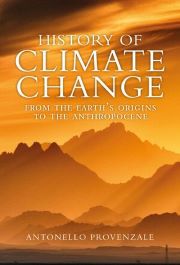History of Climate Change: From the Earth’s Origins to the Anthropocene

Antonello Provenzale (translated by Alice Kilgarriff)
Polity, £25
Climate change dominates not only the environmental headlines but also the general media, as environmental disasters begin to strike with greater frequency and intensity. Mostly such reports and linked scientific papers focus on recent climate change – i.e. that of the last century – and do not always include details of the planetary-scale processes involved.
Antonello Provenzale’s text details global climate change throughout Earth’s history. The focus is on the various cycles and processes that have always contributed to the planet’s dynamism from its inception circa 4.5 billion years ago, through millennia of natural change to the emergence of anthropogenic influence. Included are the hydrological cycle, tectonic movements, Earth/atmosphere interplay and the evolution of life, which introduced another major force to create biogeochemical cycles.
All were affected by the orbit of the Earth around the Sun, the pattern of which gave rise to the advances and retreats of polar and mountain ice sheets during the last two million years. Against this backdrop, humans evolved and began to spread worldwide. The primary anthropogenic innovation roughly 10,000 years ago that changed the world was agriculture; it profoundly altered biogeochemical cycles, ecosystems, landscapes and wildlife, and it continues to do so today. Broad-scale industrialisation began roughly 300 years ago and accelerated all those changes in biogeochemical cycles, especially the carbon cycle, the root cause of today’s increasing global temperatures and the environmental problems that they generate. The scale and rate at which change is now occurring is much greater than in the past; and there is little sign of abatement, making prediction, planning and prognostication problematic.
This book provides a valuable guide to the complexity and dynamism of natural environmental change as well as that which derives from human activity.
Dr A M Mannion
Reviewed by Dr A M Mannion, Honorary Fellow at the University of Reading Department of Geography


